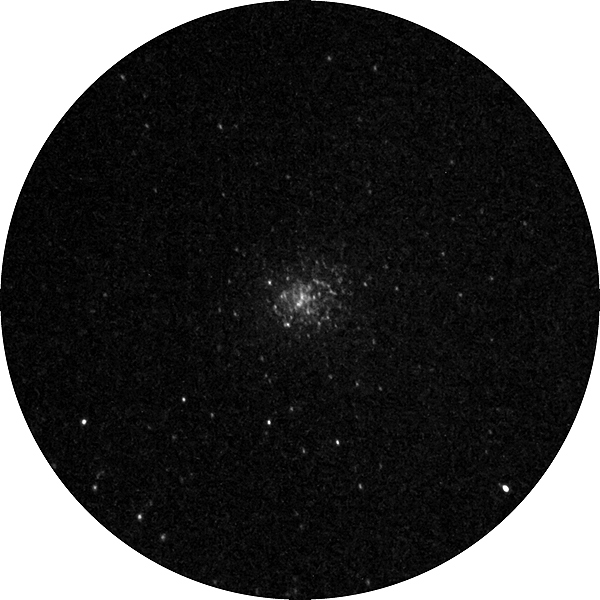iPhone Venus, Jupiter, Messier Globular Clusters;
D850 M13 Globular Cluster
Posted: 3 June 2018
Saturday morning, 2 June 2018, I went to Oracle State Park to set up two telescopes for the Friends of Oracle State Park raffle this month. Tickets are available at the Park. The raffle will be held at 6 PM on Saturday, 30 June, before that night's Star Party at the Park.
|
Open: Saturday, 2 June 2018, 1832 MST Temperature: 87°F |
Session: 1244 Conditions: Clear, breezy |
Equipment Used:
12" f/8 LX600 w/StarLock
2" 24mm UWA eyepiece
2" 9mm 100° eyepiece
1.25" 15mm eyepiece
2" 2X PowerMate
Camera:
iPhone 8 Plus
D850 DSLR
1838 MST: LX600 ON, StarLock OFF, High Precision OFF.
Viewed Venus, 102X and 271X. Good gibbous phase visible.
Attached the iPhone to the 2" 9mm eyepiece and used the camera 2X lens for video recordings using the iOS app NightCap Camera (30 seconds). This is a stack of 731 video frames for this afocal 542X image:

1853 MST: slewed to Jupiter but it was behind a tree and not yet visible. 1855 MST: Jupiter was now very faintly visible, 102X. 1907 MST: Jupiter out of the tree. The equatorial belts were visible but no moons yet as the sky was still too bright. 1915 MST: three moons were now visible (Ganymede, Io, and Europa), 102X.
1929 MST: sunset. Calm now.
1937 MST: slewed to M13 (Great Globular Cluster in Hercules). It was not yet visible against the bright twilight sky (Astronomical Twilight would end at 2107 MST). Began preparing the D850 DSLR for imaging. 1958 MST: M13 now faintly visible, 102X. 2004 MST: M13 easier to see. SYNCed on M13.
2016 MST: first two Kissing Bugs of the night seen and terminated.
2023 MST: viewed M13, 102X and 203X.
2024 MST: Kissing Bug #3 was seen but was too high on the dome to reach. Kissing Bug #4 was terminated. 2028 MST: Kissing Bug #3 was now reachable and terminated.
2042 MST: mounted the D850 DSLR at prime focus + 2X PowerMate. Focused on the star Vega using the Bahtinov Mask. 2049 MST: StarLock ON.
This is M13 (Great Globular Cluster in Hercules), prime focus + 2X PowerMate, StarLock autoguided, 1 minute, ISO 4000, White Balance 4000K:

2057 MST: StarLock OFF. Terminated Kissing Bug #5.
2103 MST: Kissing Bug #6 terminated. This was the last one seen this night.
Took at last look at M13, 102X. Slewed to Jupiter. Seeing was not very good. Three moons still visible, 102X.
Viewed Jupiter, 271X. Attached the iPhone to the 2" 9mm eyepiece. Used the camera 2X lens and NightCap Camera for a 15 seconds video, ISO 125, 1/25sec). This is a stack of 386 video frames, afocal 542X:

Removed the iPhone and switched back to the 2" 24mm eyepiece. Viewed M9 (globular cluster), 102X. It was currently too low for imaging. SYNCed on M9. Also viewed M19 and M62 (globular clusters), 102X. Both also still too low for imaging.
2200 MST the Milky Way was visible low in the eastern sky.
2203 MST: viewed M9, 163X. It was now high enough to begin imaging.
2207 MST: StarLock ON.
Did these StarLock autoguided, iPhone afocal 163X images with NightCap Camera (ISO 8448, 1/3sec, 1 minute exposures):
M9 (globular cluster)

M19 (globular cluster)

M62 (globular cluster)

2216 MST: StarLock OFF.
Viewed M62, 102X. Then viewed Omega Centauri (globular cluster) and Centaurus A (galaxy), 102X.
Lastly, viewed Saturn, 102X. It was low and seen through tree limbs.
2226 MST: LX600 OFF.
|
Close: Saturday, 2 June 2018, 2234 MST Temperature: 73°F |
Session Length: 4h 02m Conditions: Clear |
Comments are welcome using Email. Twitter users can use the button below to tweet this report to their followers. Thanks.
Cassiopeia Observatory Home Page
Copyright ©2018 Michael L. Weasner / mweasner@me.com
URL = http://www.weasner.com/co/Reports/2018/06/03/index.html
